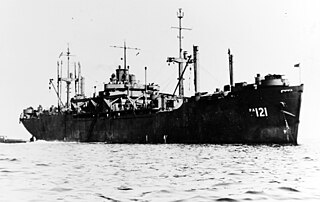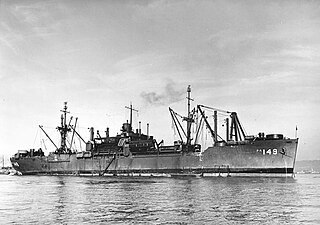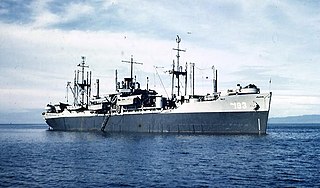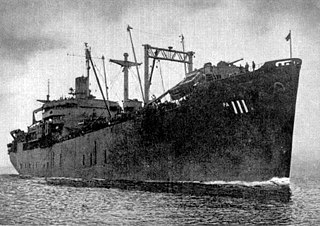
USS Humphreys (DD-236/APD-12) was a Clemson-class destroyer in the United States Navy during World War II. She was named for Joshua Humphreys, a pioneer US shipbuilder.

USS Hocking (APA-121) was a Haskell-class attack transport in service with the United States Navy. from 1944 to 1946. She was scrapped in 1974.

USS Kittson (APA-123) was a Haskell-class attack transport in service with the United States Navy from 1944 to 1946. She was scrpped in 1973.

USS Rockingham (APA/LPA-229) was a Haskell-class attack transport in service with the United States Navy from 1944 to 1947. She was scrapped in 1979.

USS Bowie (APA-137) was a Haskell-class attack transport in service with the United States Navy from 1944 to 1946. She was scrapped in 1973.

USS Audubon (APA-149) was a Haskell-class attack transport in service with the United States Navy from 1944 to 1946. She was scrapped in 1973.

USS Latimer (APA-152) was a Haskell-class attack transport in service with the United States Navy from 1944 to 1947 and from 1950 to 1956. She was scrapped in 1972.

USS Eastland (APA-163) was a Haskell-class attack transport in service with the United States Navy from 1944 to 1946 She was scrapped in 1974.

USS Hyde (APA/LPA-173) was a Haskell-class attack transport in service with the United States Navy from 1944 to 1946. She was scrapped in 1973.

USS Lauderdale (APA-179/LPA-179) was a Haskell-class attack transport acquired by the U.S. Navy during World War II for the task of transporting troops to and from combat areas.

USS Pondera (APA-191) was a Haskell-class attack transport acquired by the U.S. Navy during World War II for the task of transporting troops to and from combat areas.

USS Sanborn (APA-193) was a Haskell-class attack transport acquired by the U.S. Navy during World War II for the task of transporting troops to and from combat areas.

USS Sandoval (APA-194/LPA-194) was a Haskell-class attack transport in service with the United States Navy from 1944 to 1946, from 1951 to 1955 and from 1961 to 1970. She was scrapped in 1983.

USS Henrico (APA-45) was a Bayfield-class attack transport that served with the United States Navy in World War II, and subsequently in the Korean War, Cold War and Vietnam War.

USS Sarasota (APA/LPA-204) was a Haskell-class attack transport that saw service with the US Navy in World War II, Korean War Era and after. She was of the VC2-S-AP5 Victory ship design type. Sarasota was named for Sarasota County, Florida.

USS Telfair (APA/LPA-210) was a Haskell-class attack transport that saw service with the US Navy in World War II and the Korean War. She remained in service through most of the 1950s and 1960s, where she participated in various peacetime operations. Telfair was named for Telfair County, Georgia, which was itself named after Edward Telfair, the second Governor of the state, a member of the Continental Congress, and a signer of the Articles of Confederation.

USS Mountrail (APA/LPA-213) was a Haskell-class attack transport of the US Navy in World War II, the Korean War and Vietnam War era. She was of the VC2-S-AP5 Victory ship design type. Mountrail was named for Mountrail County, North Dakota.

USS Navarro (APA/LPA-215) was a Haskell-class attack transport of the US Navy. She was of the VC2-S-AP5 Victory ship design type that saw service in World War II and the Vietnam War. Navarro was named after Navarro County, Texas.

USS Rockwall (APA-230) was a Haskell-class attack transport in service with the United States Navy from 1945 to 1947 and from 1951 to 1955. She was scrapped in 1984.

USS Grundy (APA-111) was a Windsor-class attack transport that served with the United States Navy from 1945 to 1946. She was subsequently sold in to commercial service and was scrapped in 1973.




















